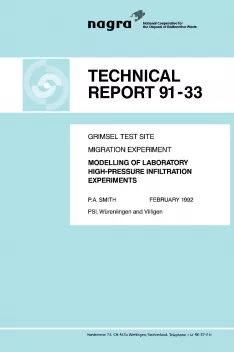
Technical Report NTB 91-33
Grimsel Test SiteMigration ExperimentModelling of laboratory high-pressure infiltration experiments
This report describes the modelling of break-through curves from a series of twotracer dynamic infiltration experiments, which are intended to complement larger scale experiments at the Nagra Grimsel Test Site. The tracers are 82Br, which is expected to be non-sorbing, and 24Na, which is weakly sorbing. The 24Na concentration is well below the natural Na concentration in the infiltration fluid, so that sorption on the rock is governed by isotopic exchange, exhibiting a linear isotherm. The rock specimens are sub-samples (cores) of granodiorite from the Grimsel Test Site, each containing a distinct shear zone. Best-fits to the break-through curves using single-porosity and dual-porosity transport models are compared and several physical parameters are extracted. It is shown that the dual-porosity model is required in order to reproduce the tailing part of the break-through curves for the non-sorbing tracer. The single-porosity model is sufficient to reproduce the break-through curves for the sorbing tracer within the estimated experimental errors. Extracted Kd values are shown to agree well with a field rock-water interaction experiment and in situ migration experiments. Static, laboratory batch-sorption experiments give a larger Kd, but this difference could be explained by the larger surface area available for sorption in the artificially crushed samples used in the laboratory and by a slightly different water chemistry.
